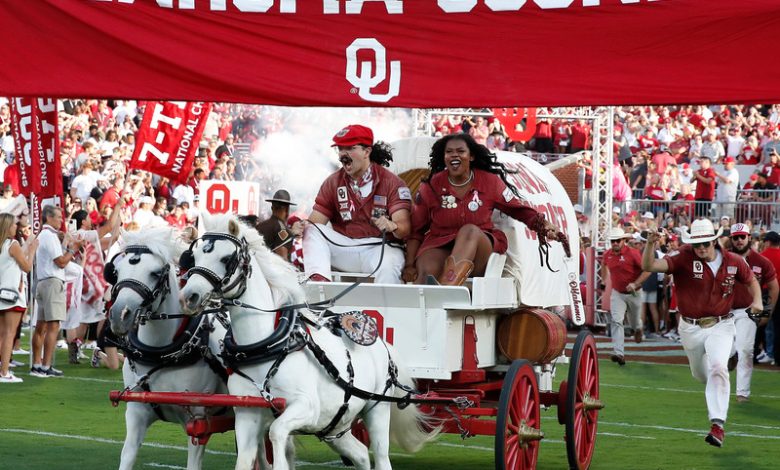According to Phil Steele’s preseason, Oklahoma was expected to rank roughly in the middle of the SEC standings, placing them among the league’s mid-level teams.

Preseason college football predictions are a staple of sports analysis, serving as a barometer for expectations, a guide for fans, and a framework for assessing team progress. Among the most respected voices in this arena is Phil Steele, whose detailed and data-driven rankings have become a trusted resource for college football enthusiasts. Each year, Steele’s projections are scrutinized and debated, as they often influence perceptions about team prospects.
In 2024, Oklahoma’s move from the Big 12 Conference to the Southeastern Conference (SEC) was among the most significant developments in college football history. This transition promised a new level of competition, increased exposure, and the chance for Oklahoma to challenge itself against some of the best programs in the country. Naturally, fans, analysts, and bettors looked to preseason predictions—particularly those from Phil Steele—to gauge where Oklahoma might stand in this new environment.
According to Steele’s preseason projections, Oklahoma was expected to rank roughly in the middle of the SEC standings, positioning them among the league’s mid-level teams. This statement encapsulates a nuanced assessment of Oklahoma’s current talent level, program trajectory, and the formidable nature of the SEC itself. To fully understand and contextualize this prediction, it’s essential to delve into the factors influencing Steele’s rankings, the characteristics of the SEC’s competitive landscape, and what this middle-of-the-pack projection signifies for Oklahoma’s immediate future.
1. The Significance of Oklahoma’s Transition to the SEC
Oklahoma’s move to the SEC marked a pivotal moment in college football. Historically, Oklahoma had been a powerhouse within the Big 12, with multiple national championships, consistent Top 10 finishes, and a reputation for producing elite talent. Transitioning into the SEC was seen as both an opportunity and a challenge.
This move was motivated by several factors:
Increased Revenue and Exposure: The SEC’s television contracts and media presence are among the most lucrative in college sports, promising financial benefits.
Enhanced Competition: Facing SEC opponents regularly would elevate Oklahoma’s strength of schedule, prepare them better for the College Football Playoff (CFP), and improve recruiting.
National Prestige: Competing in the SEC’s elite tier would bolster Oklahoma’s national stature.
However, the transition also presented immediate challenges:
Higher Level of Competition: The SEC is widely regarded as the most competitive conference, with perennial national contenders.
Adjustment Period: Oklahoma would need to adapt to unfamiliar opponents, styles of play, and conference dynamics.
Given these factors, Steele’s projection that Oklahoma would be a middle-of-the-SEC team underscores a realistic assessment of their initial positioning in this new environment.
2. Understanding Phil Steele’s Methodology and Approach to Rankings
Phil Steele’s preseason rankings are renowned for their depth and objectivity. Unlike rankings based solely on recent results or hype, Steele’s process involves a meticulous analysis of:
Returning Production: Number of returning starters, experience, and continuity.
Recruiting Rankings: Talent influx from high school and transfer portal.
Coaching Stability and Track Record: The impact of coaching staff and previous success.
Statistical Data: Offense, defense, special teams metrics, and advanced analytics.
Historical Performance Trends: How teams have progressed over recent seasons.
This comprehensive approach allows Steele to produce predictions that are grounded in quantifiable data, making his projections especially valuable when assessing a team entering a new conference.
3. The Landscape of the SEC: A League of Titans
To interpret Steele’s middle-of-the-SEC prediction, understanding the league’s composition is vital. The SEC is considered the most competitive conference in college football, featuring several programs with rich histories of success:
Alabama: Multiple national championships, consistent CFP contender.
Georgia: Recent dominant force, national champion in 2021 and 2022.
LSU: A powerhouse, especially with recent success under Brian Kelly.
Auburn, Tennessee, Florida: Programs with storied histories and competitive teams.
Mississippi State, Ole Miss, Kentucky: Middle-tier teams capable of upsetting top programs.
Vanderbilt: Generally considered a lower-tier program.
The SEC is divided into two divisions, East and West, with the top teams often competing for conference titles and playoff berths. The league’s depth and talent pool are unparalleled, making it exceedingly difficult for newcomers like Oklahoma to immediately break into the upper echelon.
Implication: A middle-tier prediction signifies that Oklahoma is expected to be competitive but not yet among the top-tier teams like Georgia or Alabama. They could be in the same tier as teams such as Arkansas, South Carolina, or Missouri.
4. Factors Influencing Oklahoma’s Predicted Standing
Several key elements underpin Steele’s projection:
a. Roster Talent and Returning Production
Oklahoma’s roster entering 2024 included a mix of returning starters and promising recruits. The transfer portal was heavily utilized, bringing in experienced players who could contribute immediately. However, as a team transitioning into a new conference, Oklahoma still needed time to fully develop cohesion and adapt to SEC-level competition.
b. Coaching and Development
Under head coach Brent Venables, Oklahoma aimed to rebuild its defense and improve overall consistency. Venables’ reputation as a defensive mastermind and recruiter suggested that Oklahoma could raise its level of play, but it would take time to implement systems and develop players.
c. Strength of Schedule and Competition
Oklahoma’s initial SEC schedule was formidable. Facing top programs such as Georgia, Alabama, LSU, and other SEC rivals in their first season would challenge their ability to accumulate wins. Steele’s projections likely account for the difficulty of these matchups, tempering expectations for immediate dominance.
d. Historical Performance and Adjustment Period
Teams transitioning into the SEC often experience a learning curve. Historically, programs like Texas A&M and Missouri took several seasons to become consistent contenders. Oklahoma’s adjustment period was expected to be similar, hence the middle-of-the-standings forecast.
5. What Does “Middle of the SEC Standings” Mean?
In practical terms, Steele’s projection suggests Oklahoma would finish somewhere around 7th to 9th in the conference standings. Given the SEC’s 14 teams divided into two divisions, this places Oklahoma squarely in the middle tier.
Key implications:
They are competitive but not yet among the conference’s elite.
They might have a winning record within the conference but could struggle against top-tier opponents.
They are poised to be bowl-eligible but not necessarily poised for a conference championship in their first season.
This positioning aligns with expectations for a team in its first year of transition, acknowledging both Oklahoma’s potential and the formidable challenge ahead.
6. The Long-Term Outlook and Potential for Growth
While Steele’s prediction is rooted in immediate expectations, it also hints at Oklahoma’s future trajectory:
Recruiting and Talent Development: As Oklahoma’s recruiting classes continue to improve, the program’s talent level will rise, allowing it to challenge the league’s top teams.
Experience and Cohesion: Over time, players will gain experience in SEC-style competition, leading to better results.
Strategic Adjustments: Coaching staff can refine game plans, exploit matchups, and build a culture suited for SEC battles.
Incremental Progress: The program’s goal would be to move upward from the middle tier to contend for SEC titles and national championships.
Historically, programs that have entered the SEC from other conferences—such as Texas A&M—have taken several years to become consistent contenders. Oklahoma’s rich football tradition and resources suggest that their climb could be quicker, but the initial forecast rightly anticipates a period of adjustment.
7. Fan and Media Reactions to the Projection
Oklahoma fans, passionate and proud of their program’s history, might have viewed Steele’s middle-of-the-SEC prediction with a mix of realism and optimism. Many understood that competing against the league’s best would be an uphill climb initially, and the projection served as a benchmark for growth rather than a discouragement.
Media outlets also analyzed Steele’s ranking critically, emphasizing that the SEC’s depth means that even talented teams can struggle to climb the standings immediately. Some analysts speculated that Oklahoma might outperform expectations if they adapt quickly, citing their recruiting prowess and coaching staff.
8. Comparing to Other Transition Teams
Looking at previous teams that moved into the SEC or similar Power 5 conferences offers perspective:
Texas A&M (2012): Faced an adjustment period, finishing near the bottom in their first few seasons before rising to contention.
Missouri (2012): Experienced early struggles but gradually improved.
Mississippi State and Arkansas: Showed that teams could take multiple seasons to become competitive.
Oklahoma’s situation was similar: a program with a proud history but new to the SEC’s demands. Steele’s projection aligns with these precedents, indicating a realistic expectation of continued growth over the coming seasons.
9. The Role of Expectations and Future Success
While Steele’s prediction focuses on the immediate future, it also influences long-term expectations:
If Oklahoma performs as predicted, it reinforces the notion that they are on the right track but need patience.
Surpassing the middle-of-the-standings mark in subsequent seasons would validate the program’s trajectory.
Conversely, underperforming could lead to reassessment of coaching strategies or roster development.
10. Final Thoughts
In sum, Phil Steele’s preseason forecast that Oklahoma would be “roughly in the middle of the SEC standings” encapsulates a balanced view of their current capabilities and the formidable nature of the league. It recognizes the program’s strong foundation, recruiting base, and coaching staff while accounting for the adjustment period necessary to compete at the highest level.
This middle-tier prediction serves as both a realistic expectation for the immediate future and a benchmark for progress. Oklahoma’s fans, coaches, and players can view it as a challenge: to rise above the middle and establish themselves as top contenders in the SEC.
Looking ahead, the journey from a middle-tier team to SEC champion is arduous but achievable. With continued development, strategic improvements, and resilience, Oklahoma has the potential to ascend the conference ranks and fulfill its ambitions of national prominence.
Phil Steele’s preseason projection placing Oklahoma in the middle of the SEC standings reflects a thoughtful, data-informed assessment of the program’s current state and the league’s competitive landscape. It underscores the reality that, while Oklahoma is a talented and historically successful program, the SEC’s depth and talent pipeline make immediate dominance unlikely. However, with the resources Oklahoma possesses and the trajectory of its program, the future remains promising. Their journey in the SEC will be an exciting narrative to follow, and Steele’s ranking provides a clear starting point from which to measure growth and success.









